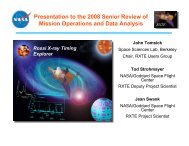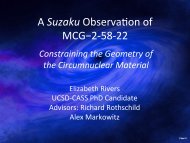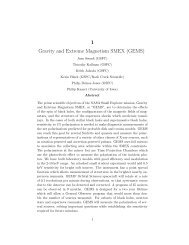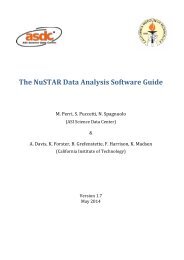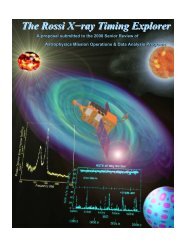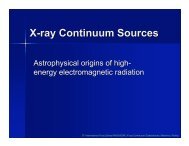Fermi Calibration Data in the HEASARC Calibration Database
Fermi Calibration Data in the HEASARC Calibration Database
Fermi Calibration Data in the HEASARC Calibration Database
- No tags were found...
You also want an ePaper? Increase the reach of your titles
YUMPU automatically turns print PDFs into web optimized ePapers that Google loves.
CAL Memo CAL/GLAST/2007-001 5<br />
1 Introduction<br />
1.1 <strong>Fermi</strong><br />
The <strong>Fermi</strong> Gamma-Ray Space Telescope is a jo<strong>in</strong>t NASA/DOE mission to survey <strong>the</strong> gammaray<br />
sky <strong>in</strong> <strong>the</strong> energy range from 10 keV to 300 GeV. <strong>Fermi</strong> was successfully launched aboard a<br />
Delta II rocket from Cape Canaveral Air Force Station <strong>in</strong> Florida at 12:05 p.m. EDT, June 11,<br />
2008. <strong>Fermi</strong> consists of 2 <strong>in</strong>struments, <strong>the</strong> Large Area Telescope (LAT) and <strong>the</strong> Gamma-Ray Burst<br />
Monitor (GBM). The GBM is an all-sky monitor similar to <strong>the</strong> BATSE <strong>in</strong>strument on <strong>the</strong> Compton<br />
Gamma-Ray Observatory (CGRO) and is designed to detect and coarsely localize gamma-ray bursts<br />
and o<strong>the</strong>r high energy transient events. The GBM <strong>in</strong>cludes 12 Sodium Iodide (NaI) sc<strong>in</strong>tillation<br />
detectors and 2 Bismuth Germanate (BGO) sc<strong>in</strong>tillation detectors. The NaI detectors cover <strong>the</strong><br />
lower part of <strong>the</strong> energy range, from a few keV to about 1 MeV and provide burst triggers and<br />
locations. The BGO detectors cover <strong>the</strong> energy range of 150 keV to 30 MeV, provid<strong>in</strong>g a good<br />
overlap with <strong>the</strong> NaI at <strong>the</strong> lower end, and with <strong>the</strong> LAT at <strong>the</strong> high end. Toge<strong>the</strong>r <strong>the</strong> NaI<br />
and BGO detectors have similar characteristics to <strong>the</strong> comb<strong>in</strong>ation of <strong>the</strong> BATSE large area and<br />
spectroscopy detectors but cover a wider energy range and have a smaller collection area.<br />
The LAT detector is designed to provide high-sensitivity detection of gamma-ray sources <strong>in</strong> <strong>the</strong> 20<br />
MeV – 300 GeV range, with f<strong>in</strong>e position resolution. The LAT consists of a four-by-four array of<br />
16 tower modules. Each tower module consists of <strong>in</strong>terleaved planes of silicon-strip detectors and<br />
tracker lead converter sheets. Silicon-strip detectors (SSDs) are able to more precisely track <strong>the</strong><br />
electron or positron produced from <strong>the</strong> <strong>in</strong>itial gamma-ray than previous types of detectors. The<br />
SSDs will give <strong>the</strong> LAT <strong>the</strong> ability to determ<strong>in</strong>e <strong>the</strong> location of a cosmic gammay-ray source to<br />
with<strong>in</strong> 0.5 to 5 arc m<strong>in</strong>utes. More details on <strong>the</strong> <strong>Fermi</strong> mission and <strong>the</strong> LAT and GBM <strong>in</strong>struments<br />
are available from <strong>the</strong> <strong>Fermi</strong> website, http://fermi.gsfc.nasa.gov.<br />
<strong>Fermi</strong> calibration data is any data obta<strong>in</strong>ed on ground or <strong>in</strong> orbit which is used to characterize <strong>the</strong><br />
properties of <strong>the</strong> spacecraft and/or <strong>in</strong>struments for <strong>the</strong> analysis of <strong>Fermi</strong> science data. <strong>Calibration</strong><br />
data may vary with time, but usually such variations are on timescales long compared to relevant<br />
observational timescales (for example, <strong>the</strong> orbital period or <strong>the</strong> slew<strong>in</strong>g timescale). <strong>Calibration</strong><br />
data may also vary with <strong>in</strong>strumental, environmental or observ<strong>in</strong>g conditions. <strong>Calibration</strong> data<br />
<strong>in</strong>cludes such th<strong>in</strong>gs as <strong>in</strong>strumental response matrices, <strong>in</strong>strumental effective areas, sensitivities,<br />
ga<strong>in</strong>s, etc., but generally excludes ancillary eng<strong>in</strong>eer<strong>in</strong>g or housekeep<strong>in</strong>g data like po<strong>in</strong>t<strong>in</strong>g histories<br />
or livetimes which might vary with each observ<strong>in</strong>g scan.<br />
Dur<strong>in</strong>g <strong>the</strong> mission <strong>the</strong> <strong>Fermi</strong> Science Support Center (FSSC ) is tasked with mak<strong>in</strong>g <strong>Fermi</strong> calibration<br />
data available to <strong>the</strong> astrophysical community <strong>in</strong> a manner consistent with <strong>the</strong> <strong>Fermi</strong> analysis<br />
software. The FSSC will produce and provide all <strong>Fermi</strong> calibration data necessary for analysis of<br />
<strong>Fermi</strong> science data <strong>in</strong> a format consistent with <strong>the</strong> specifications of <strong>the</strong> “<strong>Calibration</strong> <strong>Data</strong>base”<br />
(CALDB) at <strong>the</strong> High Energy Astrophysics Science Archive Research Center (<strong>the</strong> <strong>HEASARC</strong> ).<br />
1.2 The <strong>HEASARC</strong> <strong>Calibration</strong> <strong>Data</strong>base



